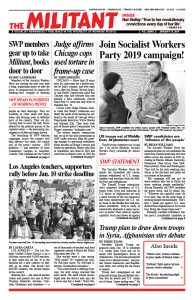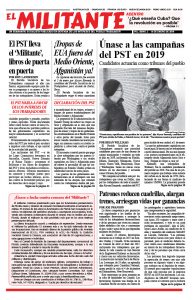Leaders of Communist Leagues in four countries — sister parties of the Socialist Workers Party in the U.S. — sent messages to the celebration of Nan Bailey’s political life. Below are excerpts from those messages, as well as from several others sent to the Dec. 30 meeting in Los Angeles.
Linda Harris of the Communist League of Australia wrote that Nan Bailey was one of many Socialist Workers Party leaders to visit there and New Zealand to aid them in building revolutionary workers parties.
Bailey toured both countries in early 1975, “speaking from firsthand experience on the battle to overturn segregation in Boston’s schools” and the fight for Black liberation. She spoke on this topic in Sydney, Melbourne, and Adelaide, as well as to 1,700 students in those cities on the struggle for women’s liberation.
The tour, Harris said, helped convince youth involved in the abortion rights fight, the struggle of Aborigines for equality and land rights, and immigrant workers from the Pacific Islands “of the need to join a party fighting for socialism.”
❖
Michael Tucker for the Communist League in New Zealand, recalling the same 1975 Pacific tour, said that more than 2,000 students, young workers, and others turned out to hear Bailey at events in six cities.
“The highly successful tour,” he added, “culminated in the founding conference of a national youth organisation of the party in New Zealand, the Young Socialists.”
Tucker said there had been prior tours by veteran SWP leaders, including George Novack, Evelyn Reed, and Harry Ring, that “played an irreplaceable role in aiding our political understanding of communist continuity and the Leninist perspective of party building.”
Bailey, however, “was much closer to the age of most of us in the League here at that time,” and “through her visit we gained confidence that in the revolutionary party, no matter your age or experience, there are no obstacles, and every encouragement, to being able to lead and act alongside other comrades to the fullest of your capacities.”
Tucker also recalled the 1981 session of the Socialist Workers Party leadership school he attended along with Bailey.
❖
Jonathan Silberman for the Communist League in the United Kingdom pointed to a 1982 Militant article quoting a report by Nan Bailey to a Young Socialist Alliance leadership meeting. The decision of both the SWP and YSA “to place our members in industrial jobs,” Bailey said, “puts us right at the center of the powerful working-class forces who will be essential to constructing a movement against imperialist war.”
This was especially important to young communists in the U.K., since they were campaigning alongside others in 1982 against the imperialist regime in London, which was waging a reactionary war against Argentina to reassert British colonial rule over the Malvinas Islands.
Understanding that deepening “our implantation in the working class as we campaigned against imperialism and war,” he wrote, was central “to winning our generation and helping forge a cadre” that founded the Communist League in January 1988.
❖
“We live at a time when the world capitalist crisis is bringing the biggest changes in bourgeois politics in decades,” wrote Michel Prairie for the Communist League of Canada.
“Nan was confident that the people from nowhere — like today’s Yellow Vests in France — are the only force able to overthrow the capitalist rulers and begin to build a new society based on human needs and not profits for a few.
“Nan’s life should not only be celebrated, but emulated by all of us.”
❖
Maggie Trowe, now a leader of the SWP living and working in Albany, New York, recalled participating with Bailey in the 1980s in a “weekly early-morning team” that sold the Militant and books by revolutionary leaders at the gate outside the GM plant in Linden, New Jersey. “We got to know quite a few workers who were glad to talk with us each week and became regular readers of the party’s paper,” she said. At the time, Trowe had a party assignment to the print shop in Manhattan that produced the Militant and books used by the party, and Bailey was organizing the secretariat of the party leadership in New York.
❖
Martha Dowling of Spartansburg, South Carolina, wrote that “Nan was the organizer of the SWP branch in Detroit at the time the Revolutionary Marxist Committee fused with the party” in 1977. “Nan played a major role making this fusion successful and especially in providing guidance to those of us ex-RMCers who stayed in Detroit after the fusion.”
Bailey “was my first real political teacher and always my inspiration,” Dowling said, as well as example “to me, and I know to many others” of “what it means to be a communist leader.”
❖
Pat (Wright) Travis of Knightsdale, North Carolina recalled working alongside Bailey, as SWP and YSA members, in building the National Black Independent Political Party in the 1980s. This break from the bosses’ Democratic and Republican parties had the potential not only to “be a step forward for the Black community, but for the working class as a whole. Nan was co-chair of the Manhattan NBIPP, and we worked together to put out a newsletter until the organization was dissolved.”
❖
Sara Gates of Seattle pointed to Bailey’s leadership in 1999 in helping supporters of the Socialist Workers Party initiate the first nationwide effort to organize regular monthly contributions to finance the SWP’s political activity in the working class. “Nan was in the Seattle branch and was assigned by the party to lead this work with party supporters,” Gates said.
After Bailey moved to Los Angeles, the two of them kept in touch. “I sent her a calendar every Christmas with watercolor scenes from Seattle. I had the same calendar, and she would ask me where I kept mine. On top of the printer at my desk. She kept hers on her desk.
“Nan was like that,” Gates said. “She listened. She was interested.”
Other messages were sent by Marie-Claire David, Raul Gonzalez, Toni Gorton, Osborne Hart, Debbie Lazar, Sam Manuel, Greg McCartan, Arlene Rubinstein, and Robbie Scherr.

